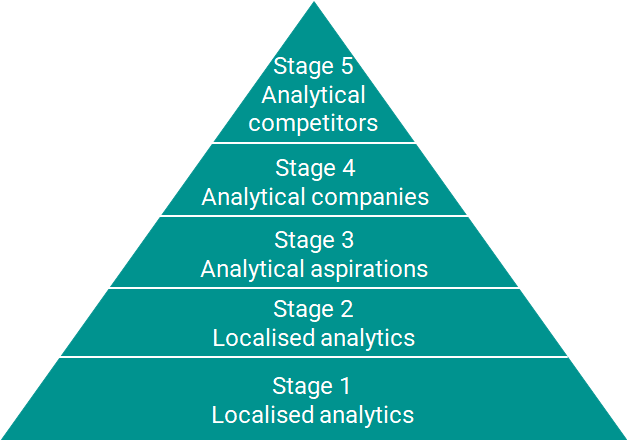Articles
Is Your Organisation Analytically Mature?
7 Factors Relating to Analytical Maturity
Is it too easy to think of analytical maturity as a step ladder? How can you reliably position yourself on that ladder? Are you too critical or too kind? Have you taken all the key aspects (perhaps even the unknown unknowns in the analytical world) into account?
Take the Analytical Maturity model presented in Thomas Davenport’s “Competing on Analytics”. Would you consider your organisation as having Analytical Aspirations or as a true Analytical Company?

It is interesting to benchmark, and here at Version 1, we have used this framework in the past, but we have found that there are often too many differing perspectives and complexities within organisations that we work with for it to be so straight forward.
In our experience, organisations differ in more ways than can be illustrated here. For example, there are those who make decisions based on experience (no, not gut feel, but years upon years of accumulated experience) and there are those who inherently and unwaveringly place their trust in analytical recommendations. For these, analytics is a day-to-day decision support system and in some cases a decision-making system. There are also organisations who have no necessity to ‘convince’ key stakeholders to use analytics in decisions, and then there are those who face staunch resistance, often a reflection of culture or organisational readiness. Some organisations that we’ve worked with consider data governance a nuisance, unnecessary red tape slowing down the decision-making process. Others would baulk at this, highlighting the essential role data governance plays in the trust and provision of insights.
Analytical Maturity Assessment
There are many lenses by which you can view analytical maturity, and it’s true that some organisations are mature in many of these but severely lacking in others.

As part of Version 1’s End-to-End Analytical Framework, We assess 7 key pivots or elements that not only help to characterise an organisation and assess an overall analytical maturity but also help to highlight the key areas for attention and what elements are necessary to improve.
The elements are displayed here on a radar chart.
Let’s take a closer look at what each represents:
Clarity of Vision
The level of senior management sponsorship for analytics and the clarity of the vision for developing an analytics capability.
Data Driven Decision Making
The ability of the organisation to gather data to effectively inform and drive decisions at all levels
Ability to Deploy Analytical Insights
Whether analytics insights are effectively deployed with the requirement for change management and performance management
Capability and Skills
The availability of key analytics skills as well as business domain expertise
IT Relationships
The degree to which IT and Line of Business work in a cooperative fashion to deliver tangible business outcomes
Analytical Roadmap
The degree to which a roadmap for the development of an analytics capability is available
Data Governance
How effective the organisation is at accessing, sharing and controlling data across the organisation
These elements often present themselves as interconnected links or axes within organisations. Consider the following two axes of analytical maturity.
Advanced Analytics:
- offers an insight driven approach that delivers outputs through easy to consume visual dashboards,
- delivers an ongoing process rather than a one-time snapshot of your inventory data,
- provides for immediate results to identify and remove obsolete stock and
- enables an on-going capability to maintain your optimal levels of different MRO inventory and improve data quality where required for better and more accurate insights.

The first axis, the Infrastructure Axis, relates the IT relationships, data governance and the use of data in making decisions. The more analytically mature organisations scale their infrastructure to support automation and real-time application of analytical models. Where one of these characteristics is lacking, there are clear constraints when attempting to scale.

The second axis is more top-down driven, the Organisational Momentum Axis. Here, the more C-Level clarity on the vision for analytics, together with a well-defined roadmap to get there and the inherent organisational support for deployment of analytical insights, then the more seamlessly actions get taken and business benefit can be realised.
In practice, analytical maturity is reflected in the interaction of these elements. Some organisations may have a strong Infrastructure Axis, but organisational culture or lack of management support see their momentum with analytics stunted. That’s also not to discount the importance of the capability and skills available to you as an organisation that will clearly determine the level of complexity in analytical techniques that is attainable.
Given Version 1’s Analytical Maturity Assessment , how would your organisation score? Which areas do you think are working well and which are stunting your growth in creating an analytics capability?
Version 1’s experienced consultants are on hand to help you understand your SPSS needs – from consultancy and training to finding the best software and license type for your analytical and usage requirements. Contact us to discuss your requirement and identify the best SPSS solution for you.
Related Articles
Take a look through our SPSS Articles covering a broad range of SPSS product and data analytics topics.





